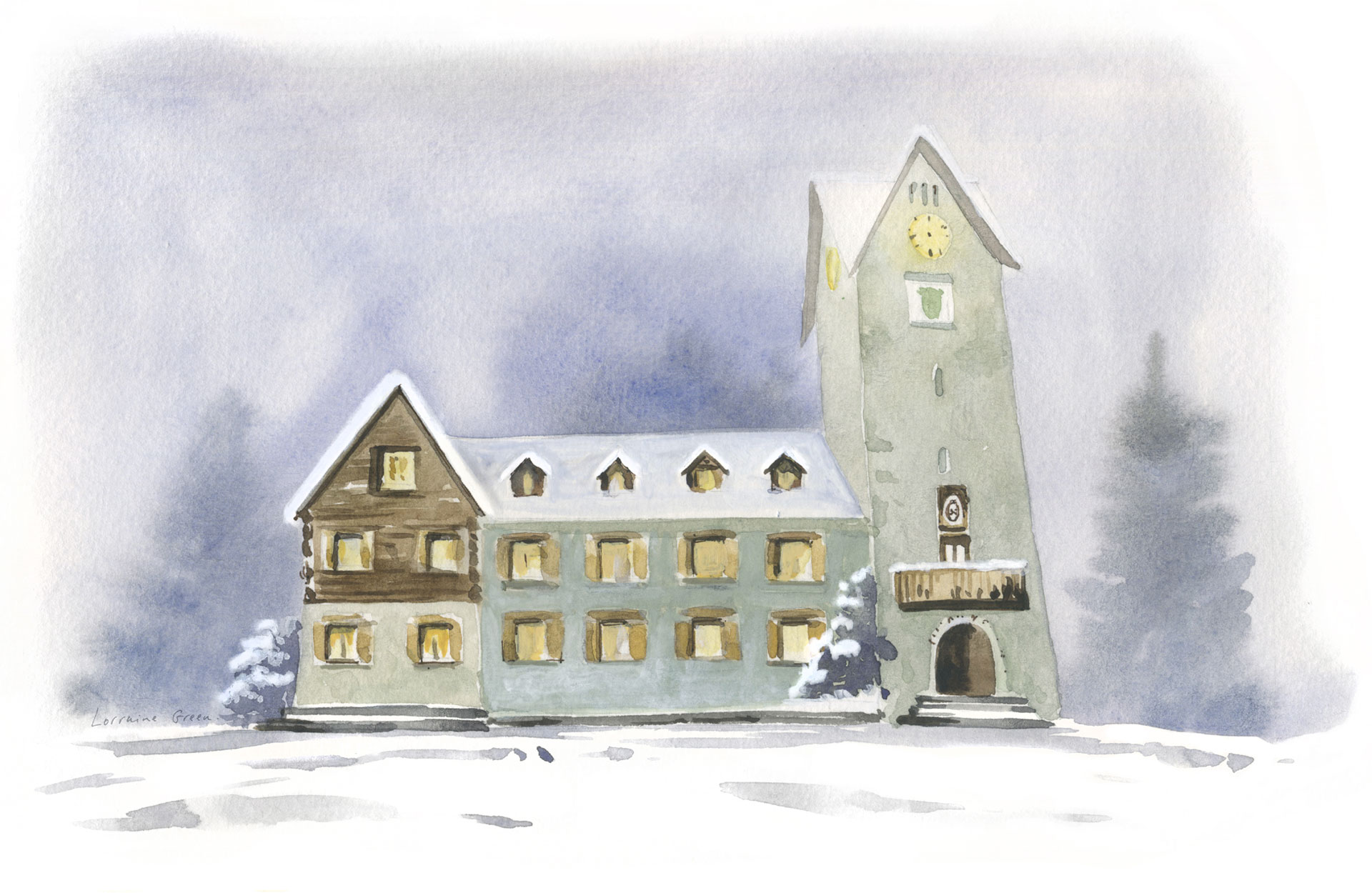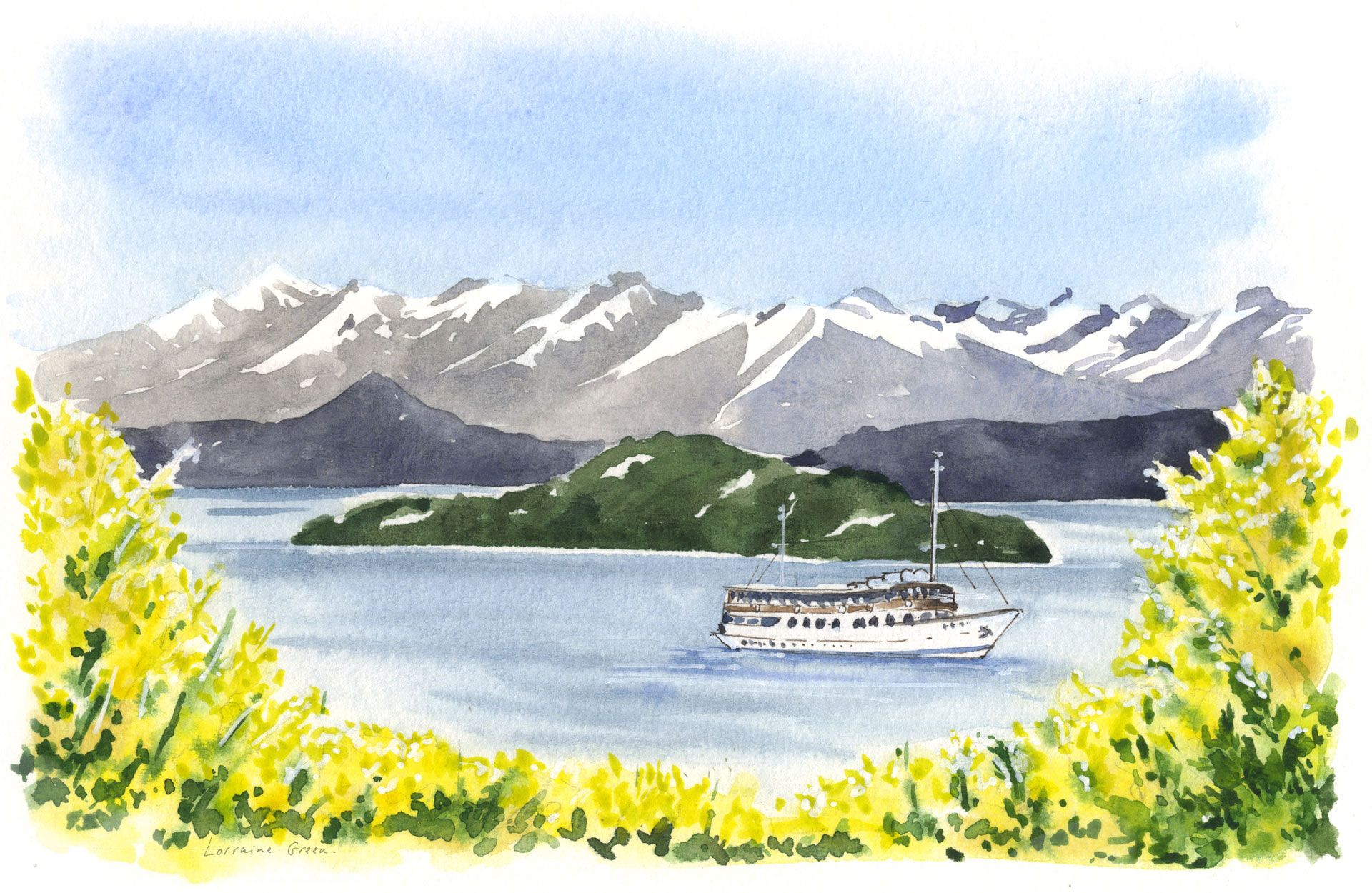Everlasting snow. Enchanted forests. Inexpressible topaz lakes. Nestled in the corner of Patagonia, Bariloche is a gem the world longs to visit. Likewise, it was the perfect setting for a group of visionaries who, nearly half a century ago, rose to the challenge of developing complex technological projects that are now distributed worldwide.
Some of our company’s iconic sites and unparalleled surroundings are captured in the following paintings.

1) INVAP was born in building #6 of CNEA’s Bariloche Atomic Center.
Room 4 in this building is where it all began. Back in 1972, INVAP founders used to meet here. They were a group of physicists and engineers who, under the leadership of Dr. Conrado Varotto, started working on applied physics projects at the National Atomic Energy Commission (CNEA). Dr. Varotto had taken postdoctoral studies at Stanford University in the Silicon Valley of California in the United States. He believed the Atomic Center in Bariloche (CAB), which was already famous for basic research, had to initiate applied research with a focus on developing technology. Thanks to Varotto’s vision and CNEA's support, the Applied Research Program was founded. This was the seed that later grew into INVAP.
As part of the National Atomic Energy Commission, this group worked on subjects closely related to the Argentine industries, both in the public and private sectors, until being convinced it was necessary to establish a technological company that could thrive exclusively from providing technological solutions to the real problems of its customers.

2) Mount Tronador as seen from Lake Hess.
This inactive volcano with glaciers and everlasting snow lies on the border between Argentina and Chile. Towering over the surrounding mountains, its 3,475 meters above sea level make it the highest peak in Nahuel Huapi National Park. The slow but constant movement of the seven glaciers on its slopes causes the seracs to frequently break off and slide down the mountaintop, causing a crashing noise that thunders throughout the valley and gives this mountain its name.
Seen from Lake Hess, a lake fed by the Manso river that originates in the glaciers, Mount Tronador is a natural symbol of Patagonia.

3) CNEA’s Uranium enrichment plant in Pilcaniyeu
INVAP’s first major project was to execute a key objective of the National Atomic Energy Commission (CNEA) and the Argentine Nuclear Program for our country: enriching uranium on its own. This was considered, from a strategic standpoint, one of the world’s most sensitive technologies. Although Argentina has never had the intention of using the nuclear program for war purposes, one of its objectives was to export research reactors. Consequently, fuel supply requiring uranium enriched to 20% had to be assured to customers. This is how INVAP started working on this project in the strictest confidence. A uranium enrichment plant at an industrial level was designed and started up in Pilcaniyeu, alongside the Pichileufu river. With this plant, which is still in operation, Argentina became a member of the Group of Nuclear Suppliers and a world model in the peaceful use of nuclear technology.
The completion of this project was publicly announced in 1983. Later on, in 1987, the plant played a leading role in the visit by Argentine president Raúl Alfonsín and Brazilian president José Sarney. This bilateral event led to a nuclear cooperation between both countries and resulted in the creation of an agency for mutual control named ABACC, which set the foundations for the current MERCOSUR.

4) Town Hall in the heart of Bariloche
Bariloche Civic Center was planned and built in 1940 by architect Ernesto de Estrada using cypress, larch wood, and stones from the nearby Cerro Carbón. Today, this place is recognized by locals and visitors alike as the architectural heart of the city. Inspired by the concept of a garden city, Bariloche focuses all the buildings of the downtown area around a central square. This main square is surrounded by constructions such as the old post office building (currently an art gallery), the former customs office, the police station, the tourist office, the Sarmiento Library, and the Patagonia Museum. Also, facing the square, the City Hall Building with a clock tower has become the site’s central and most iconic landmark.

5) The historical house Soria Moira is now home to the INVAP Foundation.
Located near the Llao Llao hotel, some 25 km from the city of San Carlos de Bariloche, there is a chalet-type house called Soria Moria, designed in the early 30s by architect Ragnvald Utne and built by businessman Nils Nilssen. It was to be used as a family home, based on the style of houses in Norway, his native country. The name of this house relates to the Scandinavian folktale on the search for the Soria Moria Castle, representing the quest for happiness.
This property was later rented and eventually bought by the Bariloche Foundation (Fundación Bariloche), a world-renowned institution in scientific, social, environmental, and cultural research. The rooms of this house hosted the design of the Latin American World Model as well as the first performance of the music chamber ensemble Camerata Bariloche. The world model was a mathematical-computational model of development representing an intersectorial socio-economic system on a global scale.
In 1979, INVAP started using Soria Moria as the headquarters for the initial uranium enrichment works and later on, for the design of the first SAC line satellites that were part of a program for Scientific Application Satellites. In 2000, this property was formally transferred to INVAP and, in 2016, the INVAP Foundation took responsibility for the care and maintenance of this house that currently hosts activities where science, art, and technology meet.
Soria Moria is at the forefront of Bariloche’s cultural and scientific development and has been declared the historical, architectural, and urban heritage of the city.

6) Winter view from the top of Cerro Campanario
At 1,050 meters above sea level, this standalone hill on the west side of San Carlos de Bariloche is known for its short, but steep inclines. It is surrounded by Nahuel Huapi and Moreno lakes and, from the top, you have spectacular sweeping sights of the area, boasting one of the world’s eight best panoramic views.
It is one of the highlighted spots visited by millions of tourists that come to our city every year and ascend to the top to enjoy the beauty of the landscape and some delicious treats at the cafe.
The stunning views allow you to see the city's urban area, the grassland plains to the east, as well as the foothills of the Andes to the west. With the Andes peaks as a perfect backdrop, the summits of López and Capilla stand out, usually dressed in white when the wintertime arrives in the Andean Patagonia.

7) Aerial view of INVAP headquarters
As the company grew and expanded, several buildings which were scattered among the city of Bariloche (some of them former hotels), were used for the company’s various purposes- from administrative offices to metalworking shops.
When faced with the need of centralizing its activities and having adequate facilities for its larger and more challenging projects, INVAP started by first building its own property: INVAP headquarters. Inaugurated in 2010 in the eastern part of the city of Bariloche, INVAP merged together clerical jobs and works involving engineering and project integration.
Within the headquarters property, the Engineering Building hosts most of the project design tasks. The Satellite Integration Building has several clean rooms for the integration of the different systems and payloads that make up a satellite mission. The Conventional Integration Building is where the final consolidation of electronic, electromechanical, and mechanical systems takes place. Finally, the Common Services Building is for the Board and General Management, the cafeteria, and the medical services.
Since its opening, our headquarters overlooking Nahuel Huapi Lake and nestled at the foot of the mountains, have become part of Bariloche’s landscape.

8) Huemul Island in Nahuel Huapi Lake
Huemul is one of the best-known islands in Nahuel Huapi Lake. It is near Bariloche’s west coast, and it is where the famous Huemul Project took place. The Austrian physicist Ronald Richter initiated a project to generate a fusion reaction, which is different from fission, now feasible in the nuclear industry. Richter’s secret labs were built on the island in the early 50s and then began the experiments. Soon after, due to the lack of results, the newly created National Atomic Energy Commission (CNEA) commissioned a group of experts to investigate the progress and feasibility of the project. The report by Dr. José Antonio Balseiro refuted Richter’s arguments and was decisive in demonstrating that the project was not going to generate a nuclear fusion reaction, considering both the theoretical grounds and the capacity of the devices used.
The facilities were promptly dismantled and most of the equipment, by recommendation of Dr. Balseiro, was used to set up a nuclear physics research center and an institute to train physicists and nuclear engineers. This series of events led to the creation of the Bariloche Atomic Center, the Balseiro Institute, and after some time, INVAP.

9) A view of Toncek Lagoon and Catedral Mountain
At the top of Mount Catedral, some 1,700 meters above the sea level, this small and shallow body of water is visited by thousands of locals and tourists all year long. It is fed by the Van Tittler creek that stems from nearby Schmoll Lagoon and goes across Toncek Lagoon on its way down the slopes of Mount Catedral to Gutierrez Lake. On the shore of this lagoon there is a mountain hut, Refugio Frey, that offers accommodations and shelter to those who go up the mountain.
In the wintertime, Toncek Lagoon freezes completely, and is well known for occasionally becoming a makeshift ice skating rink. The unparalleled landscape with rock spires that resemble towers of a cathedral give this mountain its name.

10) INVAP facilities in Bariloche’s Technological and Industrial Park
Although engineering and integration tasks are performed at INVAP headquarters, metalwork and composite material production shops are still located at various places throughout the city and outskirts of San Carlos de Bariloche.
As a result of a fruitful public-private relationship, the government of the province of Río Negro drove an initiative to create a Technological Park (PITBA), which was backed from its beginnings by INVAP. This will allow INVAP to build its second premises in this park and all manufacturing shops and spaces in connection with INVAP projects will be relocated there.
The first building to be constructed within the park is a latest generation machine shop that will be extremely valuable for machining processes both in terms of technology and fabrication capacity.

11) Scenic viewpoint
If you take a trip on the famous so-called Circuito Chico (short loop) through the west part of Bariloche, about 25 km from the city, you will get to the panoramic viewpoint, which is a classic postcard of our city.
The winding road that drives visitors to the foot of Cerro López, after a sharp turn unveils one of the most iconic panoramas in this area.
From this scenic viewpoint, you can see the historical Hotel Llao Llao, surrounded by Moreno and Nahuel Huapi lakes.
Far beyond, part of the long Victoria island as well as many other small, scattered islands in this lake are visible, and the lake is lost from sight in the Andes mountains. This view is one of the most highlighted memories for our visitors.
Credits
Illustrations: Lorraine Green
Book design and layout: Nat Filippini
Binding: Celina M. Barilatti

